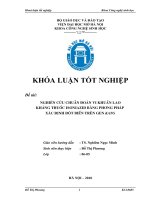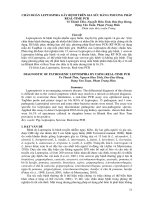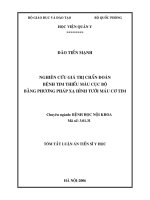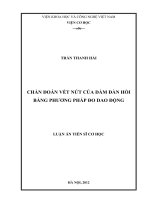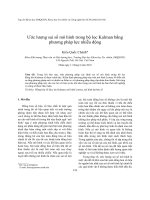Chẩn đoán vết nứt trong cần trục tháp bằng phương pháp thử nghiệm động TA
Bạn đang xem bản rút gọn của tài liệu. Xem và tải ngay bản đầy đủ của tài liệu tại đây (2.56 MB, 120 trang )
VIETNAM ACADEMY OF
MINISTRY OF EDUCATION AND
TRAINING
SCIENCE AND TECHNOLOGY
GRADUATE UNIVERSITY OF SCIENCE AND TECHNOLOGY
-----------------------------
LÊ TUẤN ANH
STUDY ON PARAMETRIZATION OF PHOTOFISSION
CROSS-SECTION OF
238
U AND OPTIMIZATION
SIMULATION USING GEANT4 FOR DESIGN OF THE
IGISOL FACILITY AT ELI-NP PROJECT
PhD THESIS IN ATOMIC AND NUCLEAR PHYSICS
Hanoi – 2021
ABSTRACT
The main focus of the thesis will be the optimization simulation using Geant4
for the design of a Cryogenic Stopping Cell (CSC) for a future IGISOL (Ion guild Isotope separation On-line) facility at ELI-NP (the Extreme Light Infrastructure: Nuc-lear
Physics). This proposed IGISOL facility will be dedicated to the study of exotic
neutron-rich nuclei produced via photo ssion of U
238
target inside CSC. A new reli-
able empirical parametrization for total cross-section, mass yield, and isobaric charge
distribution was developed in this study. A Geant4-based code was implemented for
the simulation of the photo ssion as well as the stopping of ssion fragments inside the
target foils and Helium gas. The simulation results have established the optimization
of CSC’s parameters, as well as those of the target con guration inside.
1
2
INTRODUCTION
The Extreme Light Infrastructure (ELI), which is marked on the European
Strategy Forum on Research Infrastructures (ESFRI) Roadmap as one of the
prior-ity research infrastructure projects for Europe, will be the world’s rst
international laser research infrastructure, pursuing unique science and research
applications for international users. ELI has three main research center located in
three di erent coun-tries: ELI-Beamlines facility in the Czech, the ELI-ALPS facility
in Hungary, and ELI-Nuclear Physics (ELI-NP) in Romania [1, 2, 3, 4].
ELI-NP is expected to be the most advanced research facility in the world in the
eld of photonuclear physics, and a new interdisciplinary research eld that brings
together, for the rst time, high-power lasers and nuclear physics. ELI-NP will o er a
highly-polarized tunable mono-energetic beam in the range from 200 keV to 19.5 MeV.
This kind of beam will open new possibilities for high-resolution spectroscopy at higher
nuclear excitation energies. This will lead to a better understanding of nuclear
structure at higher excitation energies with many doorway states, their damping widths
and chaotic behaviour, but also new uctuating properties in the time and energy
domain. Besides, the ELI-NP gamma beam is also suitable for the production of the
radioactive ion beam (RIB) through photo ssion of Uranium. The advance in the
understanding of nuclear structure far from stability using RIB is one of the top
priorities de ned by the nuclear physicist community in the world. To support this idea,
an IGISOL (Ion guide isotope separation on-line) facility will be constructed to extract
the photo ssion fragments to form RIBs at ELI-NP. The heart of the IGISOL is a
Cryogenic Stopping Cell (CSC), where the photo ssion process takes place. At ELINP, the development of a CSC is considered [2, 5].
For producing neutron-rich nuclei, designing nuclear physics experiments, as
well as a target system in CSC, an accurate calculation for production cross-section of
photo ssion fragments is crucial. Therefore, it is necessary to develop a reliable
3
tool for this job. This tool will be useful for estimating the yield of neutron-rich
nuclei from photo ssion process, designing nuclear physics experiments and many
other applications not only at ELI-NP but also at other photo ssion facilities
worldwide. Moreover, It is important to do series of prerequisite calculations and
simulations to lead to the conceptual design for the particular case of the CSC at
ELI-NP IGISOL facility.
The works in this thesis aim to ful ll two goals: i) the rst one is to develop a reliable
empirical parametrization for the calculation of photo ssion cross-section over a wide
energy range below 30MeV. ii) The second one is to implement a Geant4-based code and
carry out a series of simulations to optimize the design of CSC at ELI-NP.
This thesis is structured as follows. In Chapter 1, the introduction of ELI and
ELI-NP project is presented, as well as the photo ssion process, the methods for
the production of RIB, and Geant4 toolkit. Chapter 2 is dedicated to describing the
constructing process of the empirical parametrizations for total cross-section, mass
yield and Isobaric charge distribution of
238
U photo ssion. The works in Chapter 2
will ful ll the rst goal. Meanwhile, Chapter 3 is dedicated to present the
implementation of Geant4-based code and simulation results for optimizing the
design of CSC, which will ful ll the second goal. Finally, in the Conclusion part, a
summary of this work is given.
4
Chapter 1. OVERVIEW
1.1. The Extreme Light Infrastructure Nuclear Physics facility
The Extreme Light Infrastructure (ELI) is a Research Infrastructure of PanEuropean interest. ELI will be a multi-sited Research Infrastructure with complement-ary
facilities located in the Czech Republic, Hungary, and Romania for the investigation of
light-matter interactions at the highest intensities and shortest time scales [4].
ELI-NP facility in Romania, which is one of the three pillars of the ELI, will
develop a scienti c program using two beams of 10 PW laser and a Compton
back-scattering (CBS) high-brilliance and intense low-energy gamma beam [1, 2,
3]. The ELI- NP project consists of two main experimental areas: the ELI-NP HighPower Laser System (HPLS) and Gamma Beam System (GBS). Fig. 1.1
expresses the sketch of ELI-NP machines and experimental areas. The HPLS is
designed for the following study cases [1, 2, 3]:
The E1 Area host experiments of 2 10 PW laser with high density targets
for production of extremely high uxes of protons and high-Z ions, as well as
neutrons and their use in nuclear physics research and applications.
The E5 experimental area is dedicated for experiments of materials irradiation
with simultaneous, mixed types of nuclear radiation produced by two 1 PW/1
Hz laser beams.
The E6 experimental area will be dedicated to strong- eld quantum electrodynamics (QED) experiments.
Meanwhile, the study of photo ssion and the production of RIB are provided
by the Gamma Beam System, and discussed in the following subsections.
5
Figure 1.1: Sketch of the ELI-NP machines and experimental areas. HPLS High Power
Laser System; OPCPA: Optical Parametric Chirped Pulse Ampli cation; XPW: Cross
Polarised Wave system; LBTS: Laser Beam Transport System; GBS Gamma Beam
System; DPSSL: Diode Pumped Solid State Laser; E1-E8 Experimental areas. [3]
1.1.1. Gamma Beam System
A highly-polarized ( 95%) tunable mono-energetic beams of spectral density
4
of 10 photons=(s:eV ) in the range from 200 keV to 19.5 MeV with a bandwidth of
0:3% [3, 2, 5, 6] will be produced by ELI-NP GBS. These beams will be produced
through laser Compton backscattering (CBS) o an accelerated electron beam delivered
by a linear accelerator. The Compton backscattering (also called inverse Compton
scattering) is considered as "photon accelerator". Fig. 1.2 shows the geometry of the
CBS between a laser photon E L energy, incident at angle L respect to the electron
beam direction, and a relativistic electron with energy E e. The energy of out-going
6
Figure 1.2: Geometry of the inverse Compton scattering of a laser photon on a
relativ-istic electron.
gamma scattered at an angle is given by
E( )=2 e
p
2
where e = 1 (ve=c) is the Lorentz factor for electron, ve is the electron velocity, me
is the rest mass of the electron, and c is the speed of light.
Eq.(1.1) implies that by using a suitable collimator placed at certain angle,
one can select the energy of gamma beam.
As shown in Fig. 1.1, the ELI-NP gamma beam uses a green laser 0.4 J
pulse energy with the wavelength = 515nm, corresponding to an incident photon
energy EL = 2:4 eV. The maximum energy, which a scattered photon can gain is
achieved in head-on collisions, L = 0. In case of ELI-NP gamma beam, with a
given Ee, the maximum energy of gamma is [6]:
E
max
(Ee) = 9:55eV (1 +
Fig. 1.3 presents two types of beams that will be delivered at ELI-NP. The broad
gamma beam displayed with blue dots has the energy range 10 18:5 MeV. It was obtained
by using Ee = 720M eV and collimating the beam below 0.7 mrad with a lead collimator.
The red dots in Fig. 1.3 presents the pencil beam with the narrow energy range around
12.9 MeV. The pencil beam was obtained by setting Ee = 600M eV and collimating the
beam below 0.09 mrad. The energy spectra of these two beam types are
7
Figure 1.3: The simulated results for energy-angle correlation for two gamma
beams: a broad beam up to 18.5 MeV collimated below 0.7 mrad (blue) and a
pencil beam up to 12.9 MeV collimated below 0.09 mrad (red). The pencil beam is
enclosed in a dashed red box for visibility. [6]
shown in Fig. 1.4. The spectrum of broad gamma beam covers most of the Giant Dipole
Resonance region of Uranium and Thorium [7], making it suitable for the production of
exotic neutron-rich nuclei by photo ssion. Meanwhile, the narrow beam-type will be
suitable for experiments that demand a quasi-monochromatic gamma beam.
Bases on such kinds of gamma beams, ELI-NP GBS will provide the
following experiments [10, 3]:
NRF experiments: The Nuclear Resonance Fluorescence (NRF) technique is
an outstanding tool for the investigation of low-lying dipole excitations in atomic
nuclei and provides a speci c research niche for the ELI-NP facility. In experiments, the pencil gamma beams scattered o bound nuclear state will provide
access to targets that are available in small quantities and will open the actinide
8
Figure 1.4: The energy spectra of the broad beam between 10{18.5 MeV (blue
squares) and of the pencil beam at 12.9 MeV (red circles) from Fig. 1.3 [6]
.
region for NRF studies.
Photonuclear Reaction: The ELI-NP pencil beam makes it a precise tool for studies
the characteristics of photonuclear reactions, such as cross-section, Iso-
mer ratio, reaction yield.
Experiments above the Neutron Separation Threshold: The brilliant, narrowwidth, highly-polarized -ray beam will provide an opportunity to study the
nuclear photo-response at and above the particle separation threshold, such
as the pygmy dipole resonance (PDR) at and above the particle threshold,
which is essential for nucleosynthesis in astrophysics [2, 11, 3].
Nuclear Astrophysics Studies: The -induced nuclear reactions of
7
4
astrophysical, such as Li( ; t) He,
16
12
O( ; ) C . . .
9
Photo ssion experiments and the production of RIB: Because of having an
energy range that covers the whole Giant Dipole Resonant of Uranium and
Thorium isotopes [1, 2, 7], the ELI-NP gamma beam is suitable for the
produc-tion of the exotic neutron-rich isotopes in the Zr-Mo-Rh light
fragment region and in the rare-earth heavy fragment region. To support this
idea, an IGISOL facility will be constructed at ELI-NP. Some parts of the
works in this thesis will help to form the conceptual design for this future
IGISOL facility. In fact, three exist three methods for the production of RIB.
The reason for choosing IGISOL technique is discussed below.
1.2. Methods for production of RIB
To address which method is suitable for producing RIB at ELI-NP, the
details of each method will be discussed as following.
1.2.1. The ISOL technique
ISOL stands for Isotope Separation Online. In the ISOL technique, the radioactive ion beams are produced via light-ion-induced spallation or ssion of a thick actinide
target. The ssion reactions can be induced by thermal neutrons, fast neutrons, protons or photons. This method requires a high intensity of the primary beam and a thick
hot target. The great advantage of the thick targets is a large number of target atoms
available for the production of the ions. Even for such exotic nuclei with extremely low
production cross-sections can still be obtained. However, short-lived isotopes cannot
be obtained because of the time required for di usion and e usion [12, 13, 14]. Another disadvantage with ISOL production is that it is di cult to achieve high beam purity
due to the many isobars of di erent elements produced simultaneously in the target.
Furthermore, refractory elements are in general di cult to produce due to the high
temperatures required to make them volatile, see gure 1.6 [14].
The general scheme of a typical ISOL facility is shown in Fig. 1.5 . The
production of RIB by ISOL technique is summarized as follows: the primary beam
hits the target to induce the nuclear reactions, the residual nuclei is di used to the
10
Figure 1.5: Scheme of ISOL and In-Flight techniques [13, 14].
target surface by heating and, in the meantime is thermalized, neutralized due to
thick target. The reaction products then are re-ionized by ionization source and
separated by mass-separator.
The intensity of the RIB of interest depends on many factors, expressed as:
I = : :N:
:
:
:
target source separ det
where is the ux of the primary beam, is the reaction cross section, N is the number
of atoms in the target, target is the element release e ciency from the target, source
is the e ciency of the ion source, separ is the separation e ciency and det is the e
ciency of the detection system.
1.2.2. The in- ight method
The lower drawing in Fig. 1.5 expresses the scheme of In-Flight technique. In
this method, the fragmentation or ssion of intense heavy-ion beams in a thin target
made of light elements such as carbon and beryllium was used for the production of
RIB. The thin target allows the fragments to release from the target surface still at very
high velocity and forward momentum which is exploited for mass separation and study
or further reactions. An advantage of this method, which is opposite to ISOL
11
Figure 1.6: Boiling and melting point of elements
technique, is that the production of the RIBs is independent of the chemical
properties of the element. Moreover, isotopes with very short half-lives and even
isomers are available as RIBs. On the contrary, the optical properties of the RIBs
are poor due to the kinetic energy spread and their divergence that results from
the production process. Since the intensities of the heavy-ion beams are generally
lower than that of the light-ion beams used for the ISOL method, the yields of
some exotic fragments may also be somewhat lower [12].
1.2.3. Ion guide isotope separation online technique
Figure 1.7 illustrates the principle of IGISOL method based on the very begin-ning
design. The idea of this technique is that the nuclear reaction products which release from
+
the target into gas will be slowed down and thermalized in the gas cell to 1 charge state.
The bu er gas is typically helium, argon could be used in some special cases [13, 15]. In
some senses, the IGIGOL is similar to ISOL, except for the target part. Instead of using a
thick target, in this approach, one or several thin targets are
12
Figure 1.7: The principle of IGISOL method [15]
used. The release ions are swept by the gas ow out of the cell and injected
through a pumped electrode system into the isotope separator [14, 15].
The thickness of the target is limited to the range of the recoil ion in the target
to obtain the highest release e ciency. The range, for instance, is of the order of 1
2
2
mg/cm for fusion-evaporation residues and 15 mg/cm for ssion fragments [15].
1.2.4. Method for production of RIB at ELI-NP
At ELI-NP the RIB will be created through the photo ssion process, namely, the
incident particle will be gamma. Therefore, as mentioned in subsection 1.2.2, the Inight method is not suitable. The ISOL method seems to be usable for the incident
particle of gamma. However, at ELI-NP, the RIB will be dedicated to studying the
exotic neutron-rich isotopes in the Zr-Mo-Rh region which is the refractory elements.
As shown in Fig. 1.6, Zr-Mo-Rh region has a very high boiling and melting point.
Hence, they can not be di used to the target surface by heating. As a consequence,
the ISOL method is not the candidate for the production of RIB at ELI-NP.
Meanwhile, by using thin targets, the IGISOL method can be used for the
production of RIB in the refractory region. Therefore, at ELI-NP an IGISOL facility
13
will be constructed.
1.3. The future ELI-NP IGISOL
Figure 1.8 presents the layout of the proposed Gamma Beam System
located within the accelerator hall. The length of the hall is approximately 90m.
There will be two foreseen interaction points [16]:
One at E=300 MeV of electron energy identi ed as Low energy Interaction
Point (LIP).
One at E=720 MeV of electron energy respectively identi ed as High energy
Interaction Point (HIP).
The gamma beam used for photo ssion to produce RIB at the IGISOL facility will
come from the latter one.
At ELI-NP, the RIB will be produced in the photo ssion of
238
U targets induced
by the CBS gamma beam. Main components of ELI-NP IGISOL shown in Fig. 1.9
include CSC and the collimator which are installed along the beamline. The
238
U tar-
gets will be placed inside CSC lled with Helium gas. The ssion fragments will be
extracted and delivered to measurement stations through the radio frequency quadrupole (RFQ), the analyzing magnet and the MR-TOF-MS in directions depicted by red
dashed arrows [10, 5, 2]. The CSC, the Pb collimator and RFQ will be located on a
common platform, which can be placed in and out of the beam.
Note that, the gamma beam for photo ssion in CSC will be fed by the highenergy interaction point. There are two possible locations where CSC can be
mounted. The rst one is 7m far away from the high-energy interaction point, while
the other one is at 40 m from the high-energy interaction point. Fig. 1.10 depicts
the layout of ELI-NP IGISOL beamline marked by green color.
The gamma beam will generate the photo ssion fragments in a thick Uranium
target placed in the center of He gas cell used as an ion guide. To avoid long extraction
14
Figure 1.8: Gamma source schemetic layout [16, 10]. There will be two foreseen interaction points: one at E=300 MeV of electron energy and one at E=720 MeV of
electron energy respectively identi ed as Low and High energy Interaction Points.
15
Figure 1.9: Main components of the IGISOL beamline at ELI-NP [10]. It includes
CSC and the collimator which are installed along the beamline. The
238
U targets
(red-tilting rectangles) will be placed inside CSC lled with Helium gas. The ssion
fragments will be extracted and delivered to measurement stations through the
radio frequency quadrupole (RFQ), the analyzing magnet and the MR-TOF-MS in
directions depicted by red dashed arrows.
time for di usion and to increase e ciency, the target is sliced into thin foils. As
discussed in Chapter 3, many such foils are needed to obtain signi cant fragment
yields. This results in a rather long gas cell, to keep the extraction fast, imposes an ion
drift direction orthogonal to the beam direction. A strong DC eld drifts the ions out in
the orthogonal direction and, when they reach the area close to the cell wall with the
exit nozzle, resonant RF elds prevent their adhesion to the wall and push them
towards the exit nozzle where the gas ow takes them out in a supper-sonic jet. A
series of simulations have to be done to answer what are the optimal number, tilting
angle, thickness, dimensions and spacing of the targets . . . to obtain the highest
intensity of RIB. Within this thesis, the Geant4 simulation toolkit [17] is used for this
16
Figure 1.10: Layout of the IGISOL facility in the ELI-NP laboratory building, marked
by green color [16, 10].
task.
1.4. Introduction of Geant4 toolkit
The Monte-Carlo method is a statistical approach to deriving a macroscopic
solution to a problem by the use of random numbers. It involves the random
sampling of probability distribution functions that describe the problem of interest.
Provided that the algorithm is accurate and the physical system is well-modeled,
repeated sampling of the distributions will converge to the correct solution.
In the Monte-Carlo simulation of radiation transport, particles travel in discrete
steps and undergo various types of interactions along the way. The stochastic nature of
particle interactions is simulated using a pseudo-random number generator. The step
17
length and the type of interaction are sampled from cross-section data, with
geometrical constraints taken into account. A sampling of the appropriate di erential
cross sections determines the energy and direction of the resultant particles.
Geant4 which is based on the Monte-Carlo method is a toolkit dedicated to
simulating the passage of particles (heavy ions, light ions, , e, . . . ) through matter
[17]. It has been used in applications in particle physics, nuclear physics,
accelerator design, space engineering and medical physics. The Geant4 toolkit
components can be used to simulate experiments:
Geant4 allows the use of fundamental particles (leptons, hadrons, bosons, resonances, ..., included in the PDG list and ions. The description sets mass,
momentum, polarization, ...
Calculates the trajectories and determines the interactions for di erent Physical
processes: electromagnetic, hadronic, nuclear reaction and optical processes
After the interaction, it changes the particles state, creates a new particle if
needed and allows access to all the information about each interaction
Collecting this information, it is possible to describe the outcome of the detectors (even up to the level of the electronic signal) and determine what escapes
detection.
Geant4 is written in C++ following the object-oriented paradigm. Fig 1.11
shows the top-level category diagram of the Geant4 toolkit. Geant4 is exible, users
have to implement their own C++ code for their own need.
Geant4 is chosen because it provides users with many models for simulating
the transportation of particles in matter. In our case, the simulation of photo ssion
fragments traveling in targets and gas will help optimize the design of CSC. However,
the photo ssion process is not available in Geant4. Therefore, a new Geant4 process
has to be implemented for handling photo ssion. To do so, the study of photo ssion,
18
Figure 1.11: The Top Level Category Diagram of the Geant4 toolkit. The open
circle on the joining lines represents a using relationship; the category at the circle
end uses the adjoined category.
especially its cross-section, is necessary. Other processes which are useful for the work in
this thesis are well-implemented. Short description for each process is written below.
1.4.1. Energy loss of ions
The transportation of ions in media is handled by the Geant4 classes for low
energy electromagnetic interactions. More speci cally, the electronic and nuclear ion
stopping and multiple scattering e ects are applied to their kinematic parameters.
19
The class G4ionIonisation is dedicated to handling the energy loss by
positive ions with change greater than unit. Inside this class the following built-in
models can be used:
G4BetherBlochModel (Valid for proton with E > Elim )
G4BraggIonModel (valid for proton with E < Elim )
G4IonParametrisedLossModel (for ion with Z = 3-18 and 26)
The Elim = 2M eV is the limitation for proton. To calculate the limitation for
ion i with mass Mi, the following scaling relation is used [18, 31]:
Ei
lim
= Elim
where mp is ther proton mass. The scaling relation is a basic conception for the
description of ionization of heavy charged particles [18], was used in Geant4 and
ICRU Report 49 [31].
In our simulation, G4IonParametrisedLossModel is used as default. For ionmaterial combination, or projectile energy not covered by this model, the
G4BraggIonModel and G4BetheBloch models are employed [18]. The details of these
models are presented in the following subsections.
1.4.1.1. G4IonParametrisedLossModel
The model within G4IonParametrisedLossModel is the parameterisation
based on the ICRU73 stopping power tables [32]. The ICRU 73 report provides
stopping power tables for ions with atomic numbers 3{18 and 26, covering a range
of di erent elemental and compound target materials. The stopping powers
reported in ICRU 73 were derived from calculations with the PASS code [18, 32].
20
1.4.1.2. G4BetherBlochModel: The well-known Bethe-Bloch formula
G4BetherBlochModel uses the modi ed Bethe-Bloch to calculate the
average energy loss of ions, as follows [18]:
2
Q
dE
2
2
= 2 re mc nel
dx
where
re
mc
n
classical electro
2
mass-energy
electrons dens
el
I
mean excitation energy in the material
Z atomic number of the material
Q the ionic charge of the ion in units of e
E=mc
2
2
2
1 (1= )
Tmax
maximum energy transferable to a free electron
Tcut
the cut energy
Tup
min(Tcut; Tmax)
density e ect function
Ce
shell correction function
The term 2Ce=Z is the so-called shell correction function which accounts for the
interaction of atomic electrons with atomic nucleus. This term becomes more visible at low
energies and for heavy atoms. is a correction term which takes into account the
21
reduction in energy loss due to the so-called density e ect. This becomes important
at high energies because media have a tendency to become polarized as the
incident particle velocity increases.
1.4.1.3. Parameterizations at Low Energies: G4BraggIonModel
For scaled energies below 2 MeV, the shell correction becomes very large. This leads
to the degration of the precision of the Bethe-Bloch formula. To overcome this limitation, a
parameterization was included into Geant4 under the class G4BraggIonModel
[18]. The parameterization was done based on the stopping power and range
tables for alpha from ASTAR database [18] or ICRU 49 report [31]. ASTAR is a
program calculating the stopping power and range tables for helium ions in various
materials. By using scaling algorithm [18], one can obtain the stopping power and
range tables for ions with higher atomic numbers. if Geant4 material is de ned as a
NIST (National Institute of Standard and Technology) material, then ASTAR data
are used for the parameterization of stopping power. And if not, the
parameterization based on ICRU 49 is used [31].
1.4.2. Physics processes for e
+
and e
Inside gas cell, the primary e (s) are created through the ionization of ssion
fragment with helium gas and Uranium target, as well as through the interaction of
gamma beam with matter. These electrons, if have enough kinematic energy, will
ionize the helium atoms and produce the secondary electrons. Meanwhile,
positions are produced in gamma conversion process. As traveling in matter, an
electron and position can undergo ionization and production of bremsstrahlung.
These processes are handled in Geant4 by classes discussed below.
22
1.4.2.1. Ionisation of electron
The G4eIonisation class is responsible for the energy loss of electron due to
ionisation in material. By default, the energy loss is calculated by Berger-Seltzer
formula [33, 18]:
dx
dE
In an element material, the electron density is calculated as:
n
el
where Nav is the Avogadro’s number, is the density of material in which electron
propagate, and A is the molar mass of the material. In a compound material, n el is
de ned as:
n = X
el
where i implies the i
th
i
element in the compound, and w i is the proportion by mass
th
of i element with molar mass Ai.
In Eq. (1.6), the mean excitation energies I are taken from [31], while functions
F
are calculated as [18]:
2
F
+
( ; up) = ln(
up)
+ 2 up
F ( ; up) =
1
where y = 1=( + 1).
2
up
2
3 up y
+ ln [(
2
up) up] +
The last term in Eq.(1.6), , is the density e ect correction. Let’s de ne x =
log10( ) = ln(
22
)=4:606 as a kinetic variable of electron, then (x) is calculated via
23
the formalism of Sternheimer [34]:
(x) =0;
(x) =4:606x
(x) =4:606x
where the matter-dependent parameters are calculates as:
p
h p=
p
3
2
4 nelre mc = =
3
4 nelre ~c
C=1 + 2ln(I=h p)
xa =C=4:606
a =4:606(xa
m
x0)=(x1
m
x0)
=3
The values x0 and x1 depend on the state of matter. For condensed media, they
are given as following:
x
0
=0:2; x1
0
=0:326C
x0
=0:2; x1
x0
=0:326C
x
And for gaseous media, they are calculated as:
x0 =1:6; x1 = 4
x0 =1:7; x1 = 4
x0 =1:8; x1
x0
x0
x0
x0
